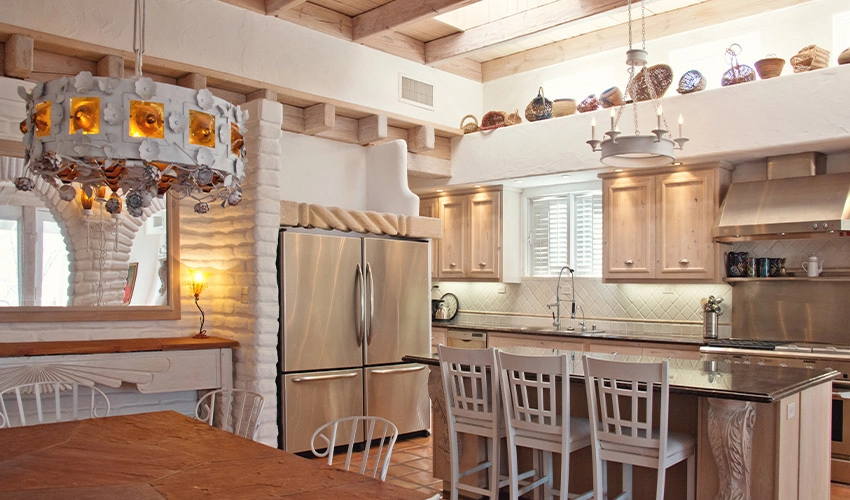Different Wall Textures | Types of Textured Walls

How to Apply 6 Different Wall Textures
Are you considering a refresh to a room’s aesthetic? Many people turn to different interior wall textures to create a finished look or to cover minor flaws in the drywall. Wall textures are quicker and easier to apply than proper drywall finishing.
Let’s take a look at seven types of textured walls and ceilings that pair beautifully with urban modern, industrial, contemporary, and bohemian design aesthetics!
Different Types of Textured Walls
When applying any wall texture, it’s essential to clean and sand the wall or ceiling, so you’re not texturing over dust or grime. When you’re mixing the mud, wait until the consistency is like pancake batter before applying.
Comb Texture
A comb texture produces a series of grooves in the wall or ceiling. It is applied with a toothed trowel and looks like rainbows, fans, or straight lines of varying widths.
It can be a simple or intricate design and allows for artistic influence and creation. To create this effect, apply the drywall compound to the wall and use the trowel's teeth to create the desired pattern.
Knockdown Texture
The knockdown texture is an excellent option for a beginner DIYer because it’s more forgiving and subtle than other textures. It creates a nice rustic look, similar to stucco.
You’ll need a knockdown knife, extension pole, spray texture gun and hopper, and two-gallon bucket. Cover the walls and everything in the room with plastic sheeting.
Mix the texture in the bucket and fill the gun. Spray the texture on the ceiling in small sections. Wait 10-15 minutes before using the knockdown knife to flatten the peaks in the texture. Steer the knife in straight lines across the ceiling. Have a rag handy to wipe excess texture off the blade.
Orange Peel
If you're looking to give your walls a retro makeover, orange peel texture is undoubtedly worth considering. It's named appropriately after an orange peel's surface, as it is an extra layer of plaster with dimples. It's an excellent choice for hiding nicks in the wall, which means less maintenance.
Once the wall is cleaned and primed, you'll need a hopper gun with an adjustable valve and an air compressor. Next, you'll mix the mud, fill the hopper, and then get to shooting!
Popcorn
The popcorn ceiling was popular in the ’70s but is still a favorite of many. It’s a great style because it hides imperfections well and can even act as a sound barrier between floors. This type of wall texture is made of Styrofoam and other materials that give a puffy appearance.
Popcorn texture is easy to apply. You’ll need the popcorn texture, air compressor, and a hopper gun. Prime the wall or ceiling before applying and cover all surfaces in the room, so you don’t spray them accidentally. Mix the popcorn texture with water (follow the instructions on the package) and spray the surface. Check out these tips for painting popcorn ceilings after it dries!
Sand Swirl
The sand swirl application is a unique way to add personality to any room. This technique leaves swirled half-circles on the wall or ceiling and can be painted any color. To create this texture, sand is added to the mix to give it a rougher application. Note: The mud for this mixture will need to be thinner than the other textures. Once you mix the mud, apply a thin layer to the wall or ceiling using a heavy-duty roller. Use a medium bristle brush (7 inches wide) to create the pattern. Let dry for 24 hours, and then you can prime and paint the wall.
Slap Brush
The slap brush texture is an excellent option for those DIYers who aren't confident using a gun to apply mud. It creates a random pattern of thin lines on your wall. All you'll need for this application is a roller, slap brush, and drywall compound.
Mix the compound with water until it becomes the paint's consistency and apply it evenly to the wall. Then apply the drywall coating to the brush and slap the brush on the wall in small sections. You do not need to follow a specific pattern; just continue slapping the wall until it's completely covered. After 24 hours, you can prime and paint.
Stomp Texture
This drywall texture is easy to apply and a popular option for ceilings. It is created by using a brush to stamp a texture onto a layer of drywall compound.
To create this texture, apply thinned-down drywall mud with a heavy nap roller or a spray gun. For a consistent look, it’s important the amount of mud applied to the wall is consistent across the entire area. Next, use a stomp brush to create the texture. To finish, remove high spots with a knockdown knife.
Professional Drywall* and Painting Services
If you’re looking to texturize, but don’t want to do it yourself, give us a call or request a free estimate online, and we’ll be happy to help! We also specialize in removing popcorn ceilings and wall textures.
*services vary by location
 Click to call
Click to call


